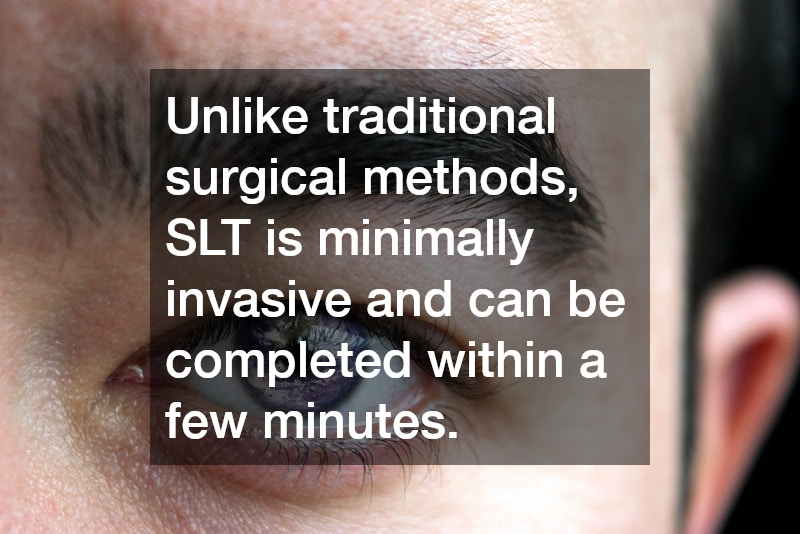Selective Laser Trabeculoplasty (SLT) is a medical procedure utilized in the treatment of glaucoma, a group of eye diseases that lead to damage of the optic nerve. The procedure was developed to help reduce intraocular pressure (IOP) in patients, which is a major risk factor for glaucoma. By targeting specific cells in the trabecular meshwork of the eye using low-energy laser pulses, SLT effectively aids in the management of this condition.
Unlike traditional surgical methods, SLT is minimally invasive and can be completed within a few minutes. It is a popular option among ophthalmologists due to its safety profile and efficacy in lowering eye pressure. The technique is known as “selective” because it specifically targets the pigmented cells within the trabecular meshwork, sparing the adjacent tissue from damage.
Furthermore, SLT can be repeated multiple times, unlike some other procedures, making it a preferred long-term management strategy for many patients. This aspect of reversibility is beneficial in maintaining patient comfort and preventing further ocular deterioration. As research on this treatment continues to grow, more extensive applications of SLT are being discovered.
How Does Selective Laser Trabeculoplasty Work?
Selective Laser Trabeculoplasty operates by emitting laser pulses to stimulate cellular activity in the eye’s drainage system. This targeted approach enhances the drainage of aqueous humor, thereby reducing intraocular pressure. The process does not involve any incisions, making it a favored choice for patients concerned about surgical risks.
The laser used in SLT is designed to precisely target melanin-rich cells, encouraging biochemical changes that promote fluid outflow. This selective targeting results in less inflammation and fewer side effects compared to other forms of laser treatment. By conserving the structural integrity of the eye, SLT minimizes post-procedure recovery time.
Most patients who undergo SLT experience a significant reduction in eye pressure within a few weeks after treatment. The effectiveness of SLT can last several years, though individual results may vary. As a non-invasive procedure, it is well-suited for patients who cannot tolerate traditional glaucoma medications.
Benefits of Selective Laser Trabeculoplasty
One of the key benefits of SLT is its ability to lower intraocular pressure without the need for invasive surgery. This presents a noteworthy advantage for patients who are at high risk of surgical complications or those who prefer a less intrusive treatment. Additionally, SLT can delay or altogether prevent the need for more aggressive surgical interventions.
Another important advantage of SLT is its repeatability, allowing patients to undergo treatment multiple times without adverse effects. This feature makes SLT a sustainable option for long-term management, especially valuable for chronic conditions like glaucoma. Moreover, SLT can be particularly useful for patients who have become refractory to medication.
SLT is also distinguished by its rapid recovery time, with most patients experiencing only mild discomfort post-procedure. The absence of significant downtime means that patients can quickly resume their daily activities with minimal disruption. Coupled with its high success rate, these benefits make SLT a compelling option within the ophthalmic community.
Potential Risks and Side Effects
While Selective Laser Trabeculoplasty is generally considered safe, there are potential risks and side effects associated with the procedure. Some patients may experience a temporary increase in intraocular pressure shortly after treatment. However, this can usually be managed with medication and does not lead to long-term complications.
There is a minor risk of developing inflammation in the treated eye, although this is typically mild and transient. It is important for patients to adhere to follow-up care instructions to monitor any adverse reactions. Rarely, the procedure might not achieve the desired pressure reduction, necessitating additional treatments or alternative therapies.
Long-term complications are uncommon, with most side effects resolving within a few days to weeks post-procedure. Patients are advised to discuss their medical history and any concerns with their ophthalmologist prior to undergoing SLT. Through informed decision-making, the potential risks can be minimized.
Conclusion
Selective Laser Trabeculoplasty stands out as an effective and less invasive option for managing glaucoma. By understanding the intricacies of how SLT works, patients and healthcare providers can make informed decisions regarding its suitability in individual cases. As medical technology advances, the scope and effectiveness of SLT will likely expand even further.
The procedure offers significant benefits, from reduced intraocular pressure to the potential for repeatability without adverse effects. Its ability to provide relief to patients who do not respond well to medication underlines its importance as a therapeutic option. SLT’s rapid recovery time and high success rate make it a favored choice in modern ophthalmology.
In summary, Selective Laser Trabeculoplasty is a powerful tool in the fight against glaucoma, offering hope to many patients worldwide. By reducing risks while maintaining efficacy, SLT enhances both clinical outcomes and patient quality of life. Continued research into this promising procedure will undoubtedly yield even greater advancements in eye care.
.
